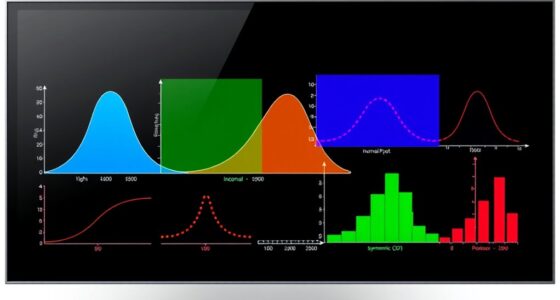Choosing the right sample size guarantees your study is accurate, reliable, and meaningful. A properly sized sample helps detect true effects, increases confidence in your results, and reduces bias. It also makes your research ethically sound and resource-efficient. Too small a sample risks missing important findings, while too large can waste resources and expose participants unnecessarily. Keep exploring to learn how to determine the ideal sample size for your study’s success.
Key Takeaways
- Proper sample size ensures study validity, credibility, and resource efficiency by balancing research goals and practical constraints.
- Larger samples increase statistical power, improving the ability to detect true effects and reducing the risk of false negatives.
- Adequate sample size enhances estimate precision, narrows confidence intervals, and supports accurate, reliable data analysis.
- Properly determined sample sizes improve study generalizability, representing broader populations and reducing bias.
- Inadequate or excessive samples can lead to unreliable results, ethical issues, resource wastage, and compromised research integrity.
Understanding the Role of Sample Size in Statistical Power

Understanding the role of sample size in statistical power is essential because it directly affects your ability to detect true effects in a study. When your sample size is larger, you increase the likelihood of correctly rejecting a false null hypothesis, boosting your study’s significance. This is because bigger samples narrow the sampling distribution, making it easier to identify genuine differences or effects. Additionally, understanding AI ethics jobs can inform how data collection and analysis are conducted responsibly. Moreover, selecting an appropriate sample size can help in achieving a refined analysis by reducing variability and increasing the accuracy of your results. However, increasing sample size isn’t free—it can raise costs and extend timelines. It’s crucial to find a balance, ensuring your study is sufficiently powered without unnecessary resource use.
How Sample Size Affects Reliability and Accuracy of Results

A larger sample size substantially enhances the reliability and accuracy of your study’s results. With more data, your estimates of population parameters become more precise, thanks to reduced standard error. Confidence intervals tighten, giving you greater assurance that the true mean falls within your range. AI security measures can benefit from larger datasets by better identifying vulnerabilities and biases. Larger samples also improve your ability to detect smaller effects, increasing the chances of finding statistically significant relationships. Variability in your results decreases, leading to more consistent findings. Additionally, a bigger, diverse sample boosts the generalizability of your conclusions to the broader population. It also makes your study more reliable by minimizing the influence of outliers and random fluctuations. Furthermore, increasing sample size can help in reducing sampling bias, ensuring that your results more accurately reflect the characteristics of the entire population.
Ethical Considerations in Determining Sample Size

Determining the appropriate sample size involves carefully balancing ethical responsibilities with scientific objectives. You need to respect participants’ rights by minimizing their burden while ensuring your study remains valuable. Proper sample size calculation also helps prevent over-recruitment, which can unnecessarily increase the risk of adverse effects or waste resources.
As the sample size grows, the burden per participant stays constant, but the overall burden increases. Therefore, smaller, well-chosen samples often offer a better value-to-burden ratio.
Ethical considerations demand avoiding unnecessary participant exposure and wasting resources. When working with vulnerable populations, you must be especially cautious to prevent exploitation or undue stress.
Ethical review boards scrutinize your sample size estimates to ensure they’re justified and scientifically sound. Striking this balance helps you conduct responsible research that respects participants’ rights while achieving meaningful, ethically justified results. Developmental considerations play a crucial role in designing ethically responsible studies.
The Impact of Sample Size on Generalizability of Findings

The size of your sample directly influences how well your findings represent the broader population. Larger samples provide better representation, reducing biases from homogenous groups and capturing more diversity. They also minimize random variability, leading to more stable and reliable results. Ring Security Cameras can offer insights into effective data collection, as their features demonstrate how technology can be used to improve monitoring and analysis. With a bigger sample, you can confidently estimate population parameters within narrower confidence intervals. This enhances the generalizability of your findings, making it easier to apply them to real-world settings. Additionally, larger samples help identify subgroup differences, which is crucial for comprehensive data analysis and understanding varied participant characteristics. Furthermore, larger samples increase statistical power, allowing you to detect smaller effects and reducing the risk of missing true relationships. While bigger samples may be costlier and time-consuming, they considerably improve the relevance and applicability of your study outcomes across broader populations.
Tools and Methods for Calculating Appropriate Sample Sizes

Calculating an appropriate sample size is essential for guaranteeing your study produces reliable and valid results. You can use statistical formulas like Yamane’s for behavioral studies with limited population data or Cochran’s for large populations, which consider margin of error, population proportion, and Z-score. There are over 100 formulas tailored to different study designs, and you can apply them manually or through software like Excel, G*Power, SAS, or R. Factors such as confidence level, margin of error, population size, data type, and study power influence your calculations. To determine your sample size, decide on your confidence level, desired interval width, and then apply the relevant formula or software. Understanding contrast ratio is important for assessing image quality in projectors, ensuring the visuals meet your desired standards. Additionally, considering the diversity of your sample can improve the generalizability of your results, especially in studies involving various demographic groups. Using these tools ensures your sample is appropriate for your research goals.
The Influence of Sample Size on Study Validity and Error Rates

A larger sample size directly enhances your study’s validity by ensuring that your sample accurately reflects the population. With more data, you reduce sampling variability, making your estimates more reliable and consistent. Sound vibrations are believed to enhance cellular regeneration and overall health, which can be better studied with larger datasets. This leads to narrower confidence intervals, giving you more precise population parameters. A bigger sample also boosts your statistical power, decreasing the chance of missing real effects (Type II errors). Additionally, it allows you to detect smaller effect sizes, increasing the sensitivity of your tests. Larger samples help identify outliers and improve the robustness of your analysis, making your conclusions more credible. Moreover, understanding the benefits of listening to classical music can inform your interpretation of data related to health and well-being studies. Ultimately, a sufficient sample size increases the generalizability of your findings, strengthening the overall validity and reducing the risk of errors that could compromise your study’s integrity.
Planning and Designing Studies With Adequate Sample Sizes

Planning and designing studies with adequate sample sizes requires careful consideration of multiple factors that influence your research’s validity and efficiency. You need to determine your desired statistical power and effect size to identify the minimum sample needed to detect meaningful effects.
Your research goals also shape your sample size, whether aiming for targeted or broad effects. The type of data—continuous or categorical—and analysis approach influence your calculations. Additionally, selecting a higher confidence level increases the required sample size.
Practical constraints like budget and resources play a role, too. Justifying your sample size guarantees ethical conduct, efficient resource use, and enhances the credibility of your findings. Incorporating proper data organization can improve data accuracy and facilitate analysis, ultimately supporting your study’s integrity.
Using tools like software, guidelines, and effect size estimates simplifies the planning process. Efficient general ledger coding can also support data accuracy and streamline financial data collection, indirectly benefiting research involving financial metrics.
The Consequences of Insufficient or Excessive Sample Sizes in Research

Choosing the right sample size is essential because both too few and too many participants can compromise your study’s validity.
Selecting an appropriate sample size ensures valid, ethical, and efficient research outcomes.
With insufficient samples, you risk low statistical power, making it hard to detect true effects, and your results may not accurately represent the broader population. This increases the chance of incorrect conclusions and reduces replicability.
On the other hand, excessive sample sizes unnecessarily expose more participants to potential risks, waste resources, and delay findings. Overly large samples can also detect trivial differences as significant, skewing interpretations.
Both extremes pose ethical issues—small samples may lead to flawed clinical decisions, while large ones can cause unnecessary harm or inconvenience.
Proper sample sizing guarantees your study is statistically sound, ethical, and resource-efficient, leading to reliable, applicable results. Additionally, understanding regional divorce statistics can help researchers interpret data within specific populations.
Frequently Asked Questions
How Does Sample Size Influence the Cost of Research Studies?
You realize that sample size directly impacts your research costs. Larger samples increase expenses due to more data collection and processing.
To save money, you might reduce the sample size, but this raises the margin of error and risks validity. Balancing cost and accuracy is essential, so you choose a size that minimizes expenses while maintaining enough precision to produce reliable results.
Can Small Sample Sizes Still Produce Valid Results?
You might think small samples can’t produce valid results, but that’s not entirely true. With careful control, focused effort, and specialized statistical methods, you can still get meaningful insights.
While small samples limit generalizability and might miss subtle effects, they’re invaluable for initial exploration or hypothesis generation. Just remember, the key is understanding your context and using rigorous techniques to guarantee your findings are as accurate as possible.
What Are Common Mistakes in Calculating Sample Size?
You often make mistakes in calculating sample size if you skip conducting a proper power analysis, rely on assumptions from other studies, or use incorrect formulas for your specific study design.
Failing to take into account study constraints like funding or ethics also leads to issues.
Make sure you account for alpha, beta, effect size, and variability, and document your calculations clearly to avoid these common pitfalls and improve your study’s validity.
How Do Ethical Issues Vary Across Different Research Fields?
You’re wondering how ethical issues differ across research fields. In humanities, you face fairness and cultural concerns, with less literature guiding you.
Medical research emphasizes informed consent, risk management, and privacy protections.
Social sciences highlight sensitivity, social justice, and power imbalances.
User research involves honesty, data privacy, and vulnerability considerations.
Each discipline demands distinct ethical diligence, demanding your awareness of unique challenges to uphold trust, protect participants, and promote responsible research practices.
Is There an Optimal Sample Size for All Types of Studies?
You’re wondering if there’s a universal ideal sample size for all studies. The truth is, no single number fits every situation.
Your ideal sample size depends on your study’s goals, design, population, and resource limits. Factors like required precision, confidence levels, and ethical considerations influence it.
Conclusion
So, next time you’re tempted to cut corners on sample size, remember—tiny samples might save time, but they’ll also save you from credible results. Overinflate your numbers, and you’ll drown in data you don’t need. Striking the perfect balance isn’t just good science; it’s a clever act of statistical survival. After all, in research, size does matter—unless you prefer your conclusions as flimsy as a house of cards.










